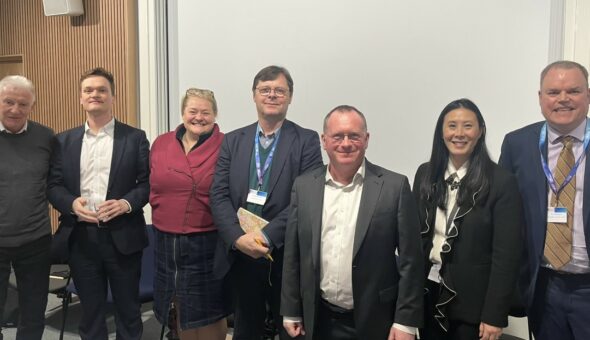This month, the Centre for Smart Warehousing and Logistics Systems (SWALOS) is taking over the Business and Society blog. The Centre is newly established, and brings together researchers in warehousing and logistics operations looking to improve operations management and decision making. We’ll hear how their members are solving problems in the field, and the business and society implications.
Here Ece Sanci explores the benefits of operational research – a key theme for SWALOS – for improving disaster relief efforts. She explains how important 'network restoration' (repairing the transport network) is when providing aid, as well as showing how her mathematical model can be used to make better decisions, helping governments and aid organisations prepare for when disaster strikes.
The incidence of natural disasters has increased dramatically in recent years. Since the beginning of 2021 alone, we’ve had extreme winter storms in the US, the Sulawesi earthquake in Indonesia, and severe flooding in Australia (barely a year after the wildfires devastated the region). We will continue to see an increase in the number of events like this unless significant action is taken to combat climate change.
In the meantime, however, relief organisations must prepare for effective disaster response. If we are to deal with this ever increasing threat, and save as many lives as possible, scholars must help improve the way we respond to disasters.
Doing good with good Operational Research
Operational research (OR) is an extremely effective tool for improving decision making. Though historically used primarily in military and manufacturing systems, this discipline has gained tremendous momentum outside these fields among high-level decision-makers in public life.
The theme of “doing good with good OR” is central to many OR scholars. Disaster relief management is a key area of application, where OR is used to improve decision-making to help people in need.
When providing disaster relief, there are many challenging decisions to be made in an environment with high level of uncertainty as well as often limited infrastructure. In this context, OR methods can provide an analytical backbone to all decisions made, helping to reduce the loss of life.
Preparing for disasters
One common practice in disaster relief management is to ‘preposition’ (or store) relief items such as water, food packages and blankets at emergency response facilities in disaster-prone regions. This way, responders need to rely less on local suppliers, who may have insufficient capacity to cope with the sudden surge in demand right after the disaster. Also, procuring these items from global suppliers may be expensive and time-consuming in the aftermath of the disaster. Therefore, prepositioning increases the effectiveness of disaster response by enabling the rapid and efficient delivery of relief items to disaster victims from a nearby emergency response facility.
Finding the best location for these emergency response facilities is a key part of disaster relief management. The quick distribution of aid is central to any response strategy, and so the facilities should be situated in the best location possible to minimise the unmet demand and cost measures.
While this topic has been explored by numerous scholars, most have ignored the importance of ‘network restoration’ in post-disaster operations. Too much emphasis has been put on the location of these centres alone - even if the emergency response facilities are well located, people will suffer if damaged roads hinder the timely distribution of relief items. What’s worse, damage to the transportation network can leave victims entirely cut off.
The importance of network restoration
Having recognised this gap in the literature, my co-author Professor Mark Daskin and I proposed to integrate the location and network restoration decisions in our paper. We developed a model to help relief organisations and government agencies better prepare for disasters by determining the locations of emergency response facilities and network restoration equipment prior to an anticipated disaster. Our model takes into account post-disaster scenarios, determining response plans for each scenario, in order to make the best pre-disaster decisions.
Our findings emphasised the importance of network restoration – we found that more/larger relief facilities have a limited impact when network restoration is ignored. However, if restoration resources are located at critical points, along with the emergency response facilities, it is possible to satisfy the total demand for relief items, more quickly and with a lower cost.
Perfecting the algorithm
Though our model produced some very helpful findings, it’s important to note that the model was solved through a heuristic algorithm. This means that it doesn’t necessarily guarantee the optimal solution. As a result, in our next paper we set out to refine this study and develop an exact algorithm to ensure that the optimal decisions are obtained in a reasonable time.
It’s challenging enough to use our model for real-world instances, even when we only consider a few post-disaster scenarios. However, for a close representation of the uncertainty in the eventual disaster situation, the model often requires more than 'only a few' scenarios. In many cases, this would cause huge solution times - commercial optimisation software packages take an incredibly long time to produce optimal solutions as the model complexity increases with the increasing number of scenarios. For example, the time it takes CPLEX – IBM’s high-performance solver – to produce an optimal solution increases cubically as the number of scenarios increases.
By contrast, the benefit of our algorithm is that the time taken to find an optimal solution increases only linearly as the number of scenarios increase. In this way, our contribution is significant as it enables considerably faster decision making. In disaster relief management, this is important as time-sensitive and life-saving decisions will need to be made in response to short-term forecasts.
I am continuing my research into disaster relief management with colleagues Dr. Melih Celik and Hannan Tureci Isik. We are currently looking at the location-routing problems of truck-drone tandems, which may provide an alternative way to maintain connectivity with regions that are inaccessible due to damaged infrastructure.
Respond



